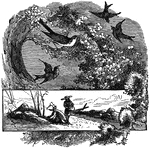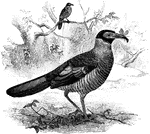
Two Radiated Ground Cuckoo, One with an Insect in its Mouth, the Other in a Tree Branch in a wooded Area
"The plumage is brownish, with white margins to the feathers and a purple tinge on the rufous-mottled…
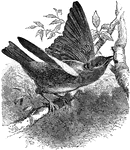
Bluebird
An illustration of a bluebird. The bluebirds are medium-sized, mostly insectivorous or omnivorous birds…
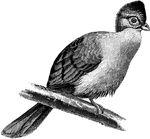
Green-Mantled Turaco Sitting on a Tree Limb
"The Gallirex chlorochlyamys, Green-mantled Turaco, has a general coloration of metallic blue and green…
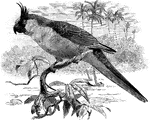
Uvaean Parakeet
The Nymphicus uvaeesis, Uvaean Parakeet, has a dark coloured face, black beak, green plumage and crest,…
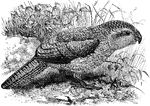
Kakapo
"Stringops habroptilus, the Kakapo or Tarapo of New Zealand has sap-green upper parts, with yellow middles…
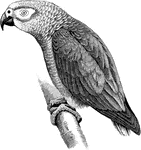
Grey Parrot
"Psittacus erithacus, the Grey Parrot, which ranges across Equatorial Africa, is ashy-grey, with black…

Leadbeater's Cockatoo Sitting on a Tree Branch
"Cacatuo leadbeateri, Leadbeater's Cockatoo, has a red crest banded with yellow and tipped with white,…

A Kea Sitting a Tree Branch
"Nestor notabilis, the Kea of the south island of New Zealand, has olive-green plumage with blackish…

Kirombo
"Leptosoma discolor, the Kiromobo or Vorondreo of Madagascar, and the Comoro Islands, which has a big…

Motmot
"Momotus brasiliensis, the Motmot, from Guiana to Northern Brazil, is somewhat similar in colour (to…
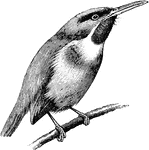
Tody
"Todus viridis, Tody, has coloration that is green, with a red throat, yellowish-white or pinkish under…

Racquet-Tailed Kingfisher
"Tanysiptera, the Racquet-tailed Kingfisher or "Paradise Kingfisher", the sexes may be similar or dissimilar,…
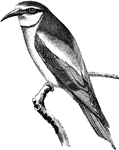
Bee Eater
"Merops Apiaster, the Bee-eater, has ruddy-brown head, neck, upper back, and broad alar bar, buff lower…
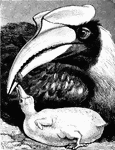
Female Hornbill Laying Down Feeding Her Young
"Dichoceros bicornis of India and the Malay countries has a large yellowish-red casque, hallowed and…

Hoopoe
"Upupa epops, not unfrequently visits Britain, where it has nested on several occasions; it breeds from…

Screech Owl
Strix flammea, the nocturnal White Screech-, or Barn Owl, is orange-buff above, with brown, grey and…
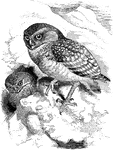
Two Burrowing Owls by the Mountains
"Speotyto cunicularia, the Burrowing Owl, a comparatively long-legged and short -winged bird with incomplete…

Common Swift Flying Through the Air by a Structure and a Tree with its Mouth Open
"The coloration of the twenty or more species of Cypselus is sooty-black or mouse-brown, frequently…
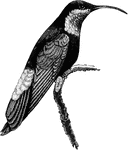
Hummingbird
"The Eulampis jugularis, or Hummingbird, has brilliant coloration almost defies description, the most…

Long Tailed Hummingbird
"Aithurus polytmus, the Long-tailed Hummingbird, peculiar to Jamaica, the two tail-feathers next to…
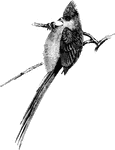
Cape Coly
"Colius capensis, or Cape Coly, has two stripes of black on the back enclosing one of white, the bare…
Quezal
"Pharomacrus mocinno, the Quezal of the higher districts of Guatemala to Veragua, is brilliant iridescent…
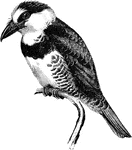
Puff-bird
"Bucco hyperrhynchus, or Puff-bird, is blue-black, with a white under surface crossed by a broad black…

Plait-billed Hornbill
The Rytidoceros undulatus, Plait-billed Hornbill, or Wreathed Hornbill, has black wings, belly, and…
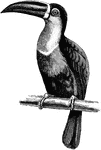
Ariel Toucan
The Rhamphastus ariel, or Ariel Toucan, is black with a yellow or orange rump and throat. The brilliant…

Lesser Spotted Woodpecker
"Dendrocopus minor, or Lesser Spotted Woodpecker, are the British representatives, The colours in this…

The Great Black Woodpecker
"Picus martius, the Black Woodpecker, an inhabitant of the pine-forests of Europe and Asia to Japan,…

A Wryneck Sitting on a Tree
"Iynx torquilla, the Cuckoo's-mate or Snake-bird, is fairly common in England, and extends thence to…

A Broadbill Sitting on a Tree Branch
"The plumage in the Calyptomena viridis of the Indo-Malay countries is bright green, with large black…

Indian Pitta
"Pitta brachyura, the Indian Pitta, has plumage that exhibits vivid scarlet, blue, and green tints,…
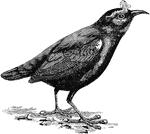
Wattled Pittas
"Philepitta, peculiar to Madagascar, which have bare orbits surmounted by a green caruncle in the male,…
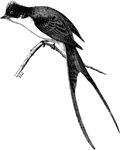
Scissor-tail
"Milvulus tyrannus, Scissor-tail, normally exhibits olive, grey, yellow, or white in varying proportions."…
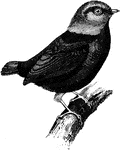
Red-capped Manakin
Pipra mentalis, the Red-capped Manakin, has black plumage with a red head, neck, and thighs.
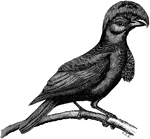
Amazonian Umbrella Bird
"Cephalopterus ornatus, the Umbrella bird, is entirely black, with a huge expanded umbrella-like crest…

Bell-Bird
"Chasmorhynchus niveus, the Bell-bird, ...have lores and orbits bare. The plumage is ordinarily plain…

The Nest of an Oven-bird
"The curious nest is placed in exposed situations on branches, in forks of trees or shrubs, on posts,…

Lyre-bird
"Menura superba, the Lyre-bird, of New South Wales and South Queensland, some thirty-three inches long,…

Skylark
"Alauda arvensis, the Sky-Lark, breed in Britain. The normal coloration is light-brown with darker longitudinal…
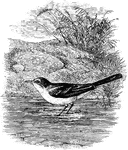
Yellow Wagtail
"Motacilla raii, the Yellow Wagtails, are generally black and white, grey and white, grey with a yellow…
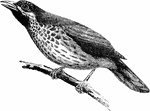
Babbling Thrush
"Timelia maculata, the Babbling Thrush, sexes are commonly alike, the plain rufous coloration being…

Paradise Flycatcher
"Terpsiphone paradisi, Paradise Flycatchers, have fine crests, shorter in the female; while fleshy wattles,…
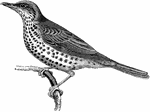
Mistletoe Thrush
"Turdus viscivorus, Mistletoe Thrush, the coloration is ordinarily plain black or brown, more or less…

Redstart
"Our Ruticilla phoenicurus,the Redstart, is grey, with brown wings, chestnut breast, rump, and lateral…

Dipper
"Cinclus aquaticus, Dippers, the colour above is normally greyish-black or brown; the lower parts are…
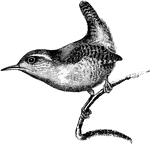
Wren
"Troglodytes parvulus, Wren, the coloration is ordinarily brown, with a great tendency to barring; spots,…
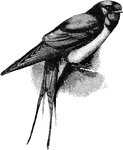
Swallow
"Hirundo rustica, the Swallow, is metallic black, with a variable amount of chestnut or rufous on the…
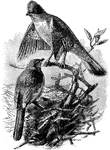
Two Grey "Coly-Shrike" Birds Sitting on Tree Branches
"Hypocolius ampelinus, Grey "Coly-Shrike", the plumage is soft, with characteristically stiff shafts…

Drongo
"Dissemurus paradiseus, the Drongo, both sexes are typically black, with metallic gloss of blue, purple,…
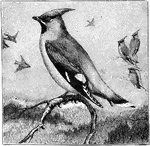
One Waxwing Sitting on a Branch in the Forefront with Three Waxwings Sitting on Branches and Four Flying Around in the Background
"Both sexes of our irregular winter-visitor the Waxwing (Ampelis garrulus) are silky greyish-brown,…
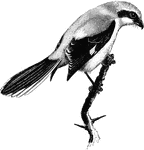
Great Grey Shrike
"The Lanius excubitor, Great Grey Shrike, lax plumage is either black, grey, and white, or is varied…
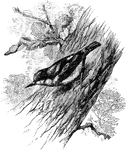
Nuthatch
"The colours in Sitta caesia, (Nuthatch) which ranges over nearly all the Palaearctic and Indian Regions,…

D'Albertis' Bird of Paradise
"Drepanornis albertisi, D'Albertis' Bird of Paradise, is rufous-brown, with green throat and ante-ocular…

Great Titmouse
"Parus major, the Great Titmouse, are olive, brown, or grey, varied with black, white, chestnut, or…
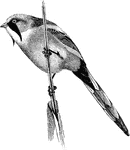
Reed Pheasant
"Panurus biarmicus, the "Bearded Tit" or "Reed-Pheasant" plumage is orange-brown above, with grey crown…

Golden Oriole
"The Golden Oriole, Oriolus galbula, which breeds exceptionally in England, is orange-yellow, with black…
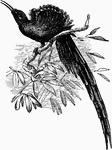
Long-tailed Bird of Paradise
"Falcinellus speciosus, Long-tailed Bird of Paradise, is black with rainbow-like reflections; the broad…
